Related Research Articles
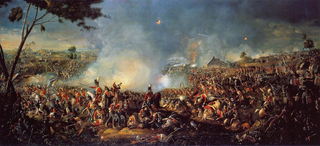
The Battle of Waterloo was fought on Sunday 18 June 1815, near Waterloo, marking the end of the Napoleonic Wars. A French army under the command of Napoleon was defeated by two armies of the Seventh Coalition. One of these was a British-led force with units from the United Kingdom, the Netherlands, Hanover, Brunswick, and Nassau, under the command of the Duke of Wellington. The other comprised three corps of the Prussian army under Field Marshal von Blücher. The battle was known contemporarily as the Battle of Mont Saint-Jean in France or La Belle Alliance in Prussia.

Sir Walter Scott, 1st Baronet, was a Scottish historian, novelist, poet, and playwright. Many of his works remain classics of European and Scottish literature, notably the novels Ivanhoe (1819), Rob Roy (1817), Waverley (1814), Old Mortality (1816), The Heart of Mid-Lothian (1818), and The Bride of Lammermoor (1819), along with the narrative poems Marmion (1808) and The Lady of the Lake (1810). He had a major impact on European and American literature.
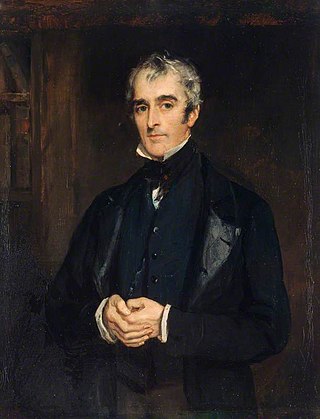
John Gibson Lockhart was a Scottish writer and editor. He is best known as the author of the seminal, and much-admired, seven-volume biography of his father-in-law Sir Walter Scott: Memoirs of the Life of Sir Walter Scott, Bart
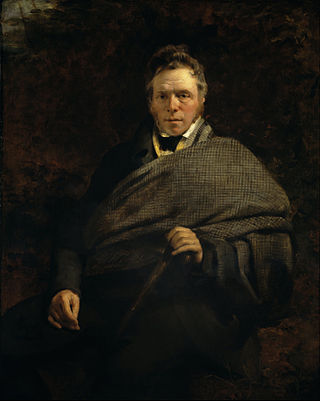
James Hogg was a Scottish poet, novelist and essayist who wrote in both Scots and English. As a young man he worked as a shepherd and farmhand, and was largely self-educated through reading. He was a friend of many of the great writers of his day, including Sir Walter Scott, of whom he later wrote an unauthorised biography. He became widely known as the "Ettrick Shepherd", a nickname under which some of his works were published, and the character name he was given in the widely read series Noctes Ambrosianae, published in Blackwood's Magazine. He is best known today for his novel The Private Memoirs and Confessions of a Justified Sinner. His other works include the long poem The Queen's Wake (1813), his collection of songs Jacobite Relics (1819), and his two novels The Three Perils of Man (1822), and The Three Perils of Woman (1823).
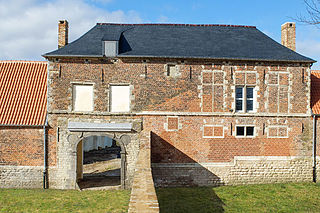
Château d'Hougoumont is a walled manorial compound, situated at the bottom of an escarpment near the Nivelles road in the Braine-l'Alleud municipality, near Waterloo, Belgium. The site served as one of the advanced defensible positions of the Anglo-allied army under the Duke of Wellington, that faced Napoleon's Army at the Battle of Waterloo on 18 June 1815.
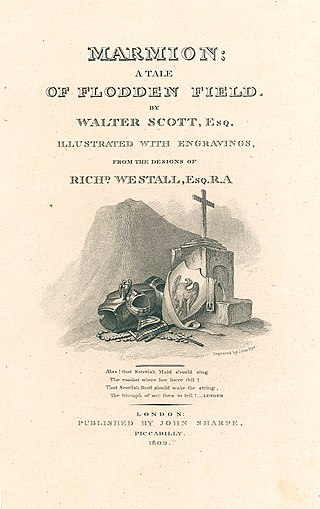
Marmion: A Tale of Flodden Field is a historical romance in verse of 16th-century Scotland and England by Sir Walter Scott, published in 1808. Consisting of six cantos, each with an introductory epistle, and copious antiquarian notes, it concludes with the Battle of Flodden in 1513.
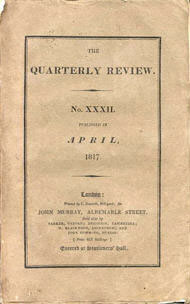
The Quarterly Review was a literary and political periodical founded in March 1809 by London publishing house John Murray. It ceased publication in 1967. It was referred to as The London Quarterly Review, as reprinted by Leonard Scott, for an American edition.

The Lay of the Last Minstrel (1805) is a narrative poem in six cantos with copious antiquarian notes by Walter Scott. Set in the Scottish Borders in the mid-16th century, it is represented within the work as being sung by a minstrel late in the 1600s.
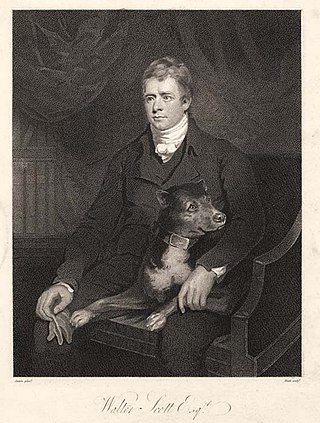
Minstrelsy of the Scottish Border is an anthology of Border ballads, together with some from north-east Scotland and a few modern literary ballads, edited by Walter Scott. It was first published by Archibald Constable in Edinburgh in 1802, but was expanded in several later editions, reaching its final state in 1830, two years before Scott's death. It includes many of the most famous Scottish ballads, such as Sir Patrick Spens, The Young Tamlane, The Twa Corbies, The Douglas Tragedy, Clerk Saunders, Kempion, The Wife of Usher's Well, The Cruel Sister, The Dæmon Lover, and Thomas the Rhymer. Scott enlisted the help of several collaborators, notably John Leyden, and found his ballads both by field research of his own and by consulting the manuscript collections of others. Controversially, in the editing of his texts he preferred literary quality over scholarly rigour, but Minstrelsy of the Scottish Border nevertheless attracted high praise from the first. It was influential both in Britain and on the Continent, and helped to decide the course of Scott's later career as a poet and novelist. In recent years it has been called "the most exciting collection of ballads ever to appear."

Events from the year 1815 in the United Kingdom. 1815 marks the end of years of war between the United Kingdom and France when the Duke of Wellington wins a decisive victory over Napoleon at the Battle of Waterloo. Fighting in the War of 1812 between the UK and the United States also ceases, peace terms having been agreed at the end of 1814. The year also sees the introduction of the Corn Laws which protect British land owners from cheaper foreign imports of corn.

The Duchess of Richmond's Ball was a ball hosted by Charlotte, Duchess of Richmond in Brussels on 15 June 1815, the night before the Battle of Quatre Bras. Charlotte's husband Charles Lennox, 4th Duke of Richmond, was in command of a reserve force in Brussels, which was protecting that city in case Napoleon Bonaparte invaded.

The Vision of Don Roderick is a poem in Spenserian stanzas by Sir Walter Scott, published in 1811. It celebrated the recent victories of the Duke of Wellington during the Peninsular War, and proceeds of its sale were to raise funds for Portugal.

The Bridal of Triermain is a narrative poem in three cantos by Walter Scott, published anonymously in 1813. It is written in a flexible metre of four and three stress lines. Set in Cumberland, it recounts the exploits of a knight as he seeks to rescue a beautiful maiden, Gyneth, the illegitimate daughter of King Arthur, doomed by Merlin 500 years previously to an enchanted sleep inside a magic castle.
Harold the Dauntless is a narrative poem in six short cantos by Walter Scott, published in 1817. It employs a variety of metres.

The Lord of the Isles is a narrative poem by Walter Scott in six cantos with substantial notes. Set in 1307 and 1314 Scotland it covers the story of Robert the Bruce from his return from exile in Ireland to the successful culmination of his struggle to secure Scottish independence from English control at the Battle of Bannockburn. Interwoven with this account is a romantic fiction centring on one of the Bruce's prominent supporters, Ronald, Lord of the Isles, involving his love for the Bruce's sister Isabel, who eventually takes the veil, and the transfer of his affections to Edith of Lorn to whom he had been betrothed at the beginning of the poem and whom he marries at the end.
Arthur Clifford (1778–1830) was an English antiquarian.

Lieutenant-Colonel Sir Alexander Gordon was a Scottish officer in the British Army who was killed at the Battle of Waterloo. His correspondence was collated and published early in the early 21st century.

Rokeby (1813) is a narrative poem in six cantos with voluminous antiquarian notes by Walter Scott. It is set in Teesdale during the English Civil War.

Magdalene Lady De Lancey wrote A Week in Waterloo, her account of the days surrounding the Battle of Waterloo, during which her husband Colonel Sir William Howe De Lancey died of his wounds.
Illustrations of Northern Antiquities (1814), or to give its full title Illustrations of Northern Antiquities, from the Earlier Teutonic and Scandinavian Romances; Being an Abstract of the Book of Heroes, and Nibelungen Lay; with Translations of Metrical Tales, from the Old German, Danish, Swedish, and Icelandic Languages; with Notes and Dissertations, was a pioneering work of comparative literature which provided translations and abstracts of various works written in medieval Germany and Scandinavia. Its three authors were Henry Weber, who précised the Nibelungenlied and Heldenbuch; Robert Jamieson, who translated Danish and other ballads, stressing their close connection with Scottish ballads; and Walter Scott, who provided an abstract of Eyrbyggja saga. It significantly extended British readers' access to early Germanic literature.
References
- ↑ Tulloch 2018, pp. 266, 268.
- 1 2 Tulloch 2018, pp. 266–267.
- ↑ Tulloch 2018, p. 266.
- ↑ The Letters of Sir Walter Scott: 1815–1817, ed. H. J. C. Grierson (London, 1933), 87 (Scott to James Ballantyne, 30 August 1815).
- ↑ Ibid., 100 (Scott to J. B. S. Morritt, 2 October [1815]); 102 (Scott to Archibald Constable, 5 October [1815]); Edgar Johnson, Sir Walter Scott: The Great Unknown (London, 1970), 507–08.
- ↑ William B. Todd and Ann Bowden, Sir Walter Scott: A Bibliographical History (New Castle, Delaware, 1998), 376–79.
- ↑ Walter Scott, Marmion: A Tale of Flodden Field, ed. Ainsley McIntosh (Edinburgh, 2018), [ii].
- ↑ For a detailed consideration of the reviews of Waterloo see J. H. Alexander, The Reviewing of Walter Scott's Poetry: 1805‒1817, Vol. 2 of Two Studies in Romantic Reviewing (Salzburg, 1976), 405‒07.
- ↑ The Scourge, 10 (December, 1815), 437‒51 (450).
- ↑ The British Critic (new series), 4 (November 1815), 528‒32.
- ↑ The Critical Review Series the Fifth, vol. II, no. I, pp. 457–463.
- ↑ Tulloch 2018, pp. 268–269.
- ↑ Baron John Campbell, The lives of the lords chancellors and keepers of the great seal of England: from the earliest times till the reign of King George IV, vol. 6 (1851), p. 518
- ↑ Tulloch 2018, p. 269.
Bibliography
- Gottlieb, Evan. 'Fighting Words: British Poetry and the Napoleonic Wars', in Romantic Globalism: British Literature and Modern World Order, 1750–1830, University of Ohio Press, 2014, pp. 68–94.
- Semmel, Stuart. 'Reading the Tangible Past: British Tourism, Collecting, and Memory after Waterloo', Representations, 69 (2000), pp. 9–37.
- Shaw, Philip. 'Walter Scott: The Discipline of History', in Waterloo and the Romantic Imagination, Palgrave Macmillan, 2002, pp. 35–66.
- Tulloch, Graham (October 2018). "Walter Scott and Waterloo". Romanticism . Edinburgh University Press. 24 (3): 266–277. doi:10.3366/rom.2018.0386. ISSN 1354-991X. S2CID 165188924.